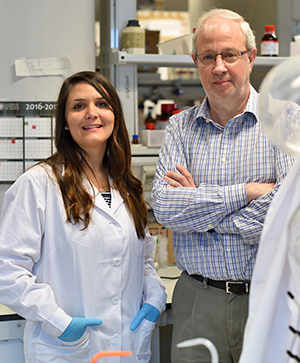Ecstasy Detector
Through IDM, the UPV is participating in the development of a simple, reliable, fast and selective low-cost system
[ 29/05/2017 ]
A research team composed of groups from the Polytechnic University of Valencia (UPV), the Spanish Centre for Biomedical Research in Bioengineering, Biomaterials and Nanomedicine (CIBER-BBN), the University of Southern Denmark, Odense, and the Institute of Polymer Chemistry (ICP)-Johannes Kepler University (Linz, Austria) has developed a new sensor that can detect the presence of ecstasy simply, reliably, fast, selectively and economically.
The system of nanoparticles generated by the research team gives an immediate visual response: if a pill contains ecstasy, when it is diluted in water the liquid's fluorescence instantly rises and reveals the presence of the drug.
The work has been described in a paper published in the Chemical Communications Journal.
Psychostimulant that can cause paranoia and heart failure
Ecstasy is one of the most widely consumed drugs at the present time and can cause memory problems, paranoia, insomnia, high blood pressure and even heart failure, among other disorders.
Up to now, its detection and quantification have been obtained by techniques such as Capillary electrophoresis, spectroscopy and chromatography, methods which, according to Beatriz Lozano, researcher at the Interuniversity Research Institute for Molecular Recognition and Technological Development (IDM) are "perfectly viable, but they require the use of special equipment that is both expensive and has to be applied by skilled operators. On the other hand, our system stands out for its ease-of-use, low cost and reliability".
A molecular gate formed by a combination of the blue box and naphthol retains the dye
The method created by the Spanish, Danish and Austrian research team consists of a hybrid material that includes an inorganic support with a dye (Fluorescein) and is functionalised with an organic molecule derived from naphthol.
The colorant is retained when the blue box (a molecule widely used in Chemistry) coordinates with the naphthol and forms a molecular gate. If the sample analysed contains ecstasy its fluorescence is modified in proportion to the concentration of the drug detected.
Researcher Beatriz Lozano explains "blue box was already known to have an affinity with different neurotransmitters such as dopamine, and since this neurotransmitter is structurally similar to ecstasy, we thought it would be a good idea to try to make the molecular gate open in the presence of the drug and thus liberate the dye, which gives the fluorogenic response".
According to the tests carried out in the laboratory, among its other qualities, this new system is unique for its high sensitivity, up to 0.95 micrograms / millilitre.
The next stage and new lines of research
The researchers' next step will be to embed the hybrid material in an aluminium plate, "to make en situ detection even faster", says Lozano.
The UPV's IDM research team is currently working on a new sensor that will be able to detect other synthetic drugs.
Outstanding news
 ARWU 2023
ARWU 2023
The Shanghai ranking reaffirms the UPV as the best polytechnic in Spain for yet another year
 Science Meets Regions CV 2023
Science Meets Regions CV 2023
The UPV and the Almussafes City Council begin a collaboration in search of solutions to maintain the automobile sector in the Valencia Region
 Scientific reference
Scientific reference
Avelino Corma, Distinguished Research Assistant at the UPV, awarded an Honorary Doctorate by the University of Huelva
 Micronanofabs NTC UPV-PERTE CHIP Conference
Micronanofabs NTC UPV-PERTE CHIP Conference
María Marced, TSMC Europe president: "The sector's future is bright, the market is expected to double by 2030"
 Goya nomination
Goya nomination
Javier Polo, who holds a degree in Audiovisual Communication from the UPV, directs the successful short documentary Una terapia de mierda
 Sant Carles Medal 2023
Sant Carles Medal 2023
The Faculty of Fine Arts of the UPV awards the Sant Carles Medal 2023 to outstanding Valencian art and culture figures







